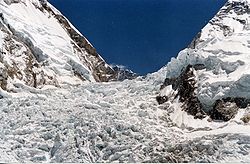2014 Mount Everest avalanche

The Khumbu Icefall in 2005. The ice avalanche came from a serac failure from an ice bulge on Mount Everest's western shoulder (centre left), above the icefall.
|
|
| Time | 06:45 local time (01:00 UTC) |
|---|---|
| Date | 18 April 2014 |
| Location | Khumbu Icefall, Mount Everest |
| Coordinates | 27°59′32″N 86°52′38″E / 27.99222°N 86.87722°ECoordinates: 27°59′32″N 86°52′38″E / 27.99222°N 86.87722°E |
| Cause | Avalanche |
| Deaths | 16 |
| Non-fatal injuries | 9 |
On 18 April 2014, seracs on the western spur of Mount Everest failed, resulting in an ice avalanche that killed sixteen Nepalese guides in the Khumbu Icefall. This was the same icefall where the earlier 1970 Mount Everest disaster took place. Thirteen bodies were recovered within two days, while the remaining three were never recovered due to the great danger of performing such an expedition. Some Sherpa guides were angered by what they saw as the Nepalese government's meager offer of compensation to victims' families, and threatened a protest or strike. On 22 April, the Sherpas announced they would not work on Everest for the remainder of 2014 as a mark of respect for the victims.
A Mount Everest guide typically earns about US$125/day per climb. Most come from climbing families, are raised on stories of wealth from climbs, with relatively few other economic opportunities. Between 350 and 450 guides, most of them Sherpas, work each year's climbing season. A guide can earn up to $5,000 a year, compared with Nepal's average annual salary of $700.
In the years prior to the disaster, foreigners began bringing their own guides, causing tension with locals. Eight people, including one of the most experienced Sherpa guides, died on Mount Everest in 2013.
The presence of numerous unstable blocks of ice (called seracs) in and above the Khumbu Icefall encourages climbers to try to pass through as quickly as possible, usually in early morning before temperatures rise and loosen the ice. In the spring of 2012 Russell Brice, of the guiding company Himex, called off guided ascents run by his company due to safety concerns. He was worried about the stability of a 300 metres (980 ft) wide ice cliff, or ice bulge, on Mount Everest's western shoulder that could endanger the route through the Khumbu Icefall, if it collapsed. "When I see around 50 people moving underneath the cliff at one time," he commented, "it scares me." However, Brice and Himex returned to the south side of Everest for the 2014 climbing season. Mountaineer Alan Arnette reported that this ice bulge had been a known hazard for years and had discharged ice into the Khumbu Icefall almost every season. He added that, "In 2012 it narrowly missed many climbers." According to writer and mountaineer Jon Krakauer, the 2014 ice avalanche was triggered when a block of ice "the size of a Beverly Hills mansion" broke off from the bulge.
...
Wikipedia
